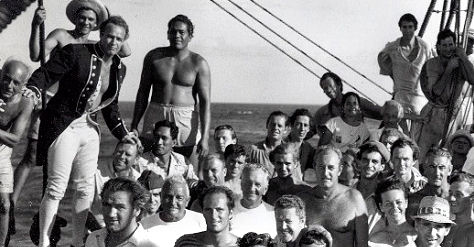Christian Bale is locked down to play the Van Heflin role in James Mangold‘s 3:10 to Yuma. That’s the less charismatic role, as if you had to be told. Russell Crowe has the cool-bad-guy Glenn Ford role, or the one that Tom Cruise was going to play before he bailed over…I don’t why he bailed. (Does anyone?) Columbia Pictures bailed on this oater a while back, but now Relativity Media is going to cover production costs.
Day: August 4, 2006
Meryl’s Oscar shot
I haven’t spoken to anyone at 20th Century Fox, but a guy who knows everyone and everything is saying the plan is for Meryl Streep‘s The Devil Wears Prada peformance to be put up for Best Actress. And in the words and cadence of David Mamet, I say no, no, a-thousand- times-no to that. Meryl isn’t the main character in Prada — Anne Hathaway is — and she won’t have a snowball’s chance in hell if she goes for Best Actress. And forget about her spirited performance in A Prairie Home Companion. That’s strictly backup, strictly “oh, yeah, she was good in that too.”
Eammon on “Jesus”
Magnolia Films chief Eammon Bowles called earlier today to explain his position about not wanting Michael Moore to show Jesus Camp, a doc about evangelicals, at the Traverse Film Festival . The film, directed by Heidi Ewing and Rachel Grady, is a balanced look at evangelicals, he says, and he doesn’t want Average Joes in middle America getting the idea that it’s a lefty, anti-Christian thing because they would almost certainly interpret Moore’s support of the film as evidence that it is, most likely, a lefty, anti-Christian thing.
Eammon has a good practical point, but even if Jesus Camp is as balanced and even-toned as he says it is, we all know who and what evangelicals are. They’re devout intense people who basically believe in a kind of fundamental absolutism, which is what hard-core righties are also about, which is why they’re generally regarded as being in more or less the same camp. But c’mon, honestly…does anyone anywhere know of any evangelicals who are liberal-minded and drive hybrid cars, and who voted for John Kerry in ’04? The most vile thing that has ever happened by way of American culture is the American right’s co-opting of the teachings of the gentle, imbued Yeshua.
As Max von Sydow‘s character says in Woody Allen’s Hannah and her Sisters, “If Jesus were to come back to the earth and see what’s going on [here] in his name, he would never stop throwing up.”
Glory is fleeting
“Glory is fleeting, but obscurity is forever.” — Napoleon Bonaparte. In other words, better to have ridden high and drunk the electric brew, however briefly, than to have never ridden at all.
Gibson again
This 8.4 Associated Press article is the first significant “soft” piece about Mel Gibson. It has quotes from some Giibson friends, some of them Jewish, giving him a pass. Okay, fine. But a guy I know who worked with Gibson over a decade ago, and he’s has written and told me he “believe[s] all this shit.” He calls Gibson a “bigoted man, now and forever” and “a bigoted son of a bitch.” But life is fluid and moving and people grow. Look at how Bobby Kennedy evolved from ’62 to ’67. And the impulse to stand by a guy you like or respect during his hour of need is a noble one. We all need understanding, forgiveness, a second chance. Let’s just leave it at that.
Brando Bounty
It took them several years, but Warner Home Video is finally about to release a big swanky DVD of the 1962 Marlon Brando version of Mutiny on the Bounty. The film has been re-mastered from the original 65mm elements and will be presented in the original 2.76 to 1 Ultra-Panavision aspect ratio. This version hasn’t been seen by anyone since Bounty‘s big-city, reserved-seat showings some 44 years ago.
It’ll be part of a spiffy new Marlon Brando Collection box set hitting stores on 11.7.06. The set will also include a purist remastering of John Huston‘s Reflections in a Golden Eye (’67) that will recreate the golden pinkish hues that this disturbing film was presented with during its initial run. It’ll also include a remastered version of Joseph L. Mankiewicz‘s Julius Caesar (’53), which I wrote an item about just a few days ago.

(l. to r.) Trevor Howard, Marlon Brando, Richard Harris and Percy Herbert in Lewis Milestone’s Mutiny on the Bounty
The lesser titles in the set are Teahouse of the August Moon (’56), which features Brando’s strange performance as a cheerful Taiwanese translator named Sakini, and John Avildsen’s The Formula (’80), in which a fat, white-haired Brando plays a no-good oil company mogul.
Say what you will about the ’62 Bounty‘s problems — historical inaccuracies and inventions, Brando’s affected performance as Fletcher Christian, the floundering final act. The fact remains that this viscerally enjoyable, critically-dissed costumer is one of the the most handsome, lavishly-produced and beautifully scored films made during Hollywood’s fabled 70mm era, which lasted from the mid ’50s to the late ’60s.
Roger Donaldson‘s The Bounty (’84) is probably a better Bounty flick (certainly in terms of presenting the historical facts), but the ’62 version has more big-buck, oom-pah swagger. The sets seem flusher and more carefully varnished and arranged, Robert Surtees‘ widescreen photography is more vivid and precisely lit and generally more eye-filling than Arthur Ibbetson‘s for The Bounty, and Bronislau Kaper‘s orchestral score is more deep-down stirring than the quieter ’84 score by Vangelis.
The Brando Bounty is a dated film in some ways (okay, a lot of ways), but it has a flamboyant “look at all the money we’re spending” quality that’s half-overbaked and half-absorbing. It’s pushing a kind of toney, big-studio vulgarity that insists upon your attention.
There’s a way to half-excuse Bounty for doing this. It was made, after all, at a time when self-important bigness was regarded as a kind of aesthetic attribute unto itself, with large casts, extended running times, dynamic musical scores (overtures, entr’actes, exit music) and intermissions all par for the course. And there’s no denying that a lot of skilled craftsmanship and precision went into this manifestation.
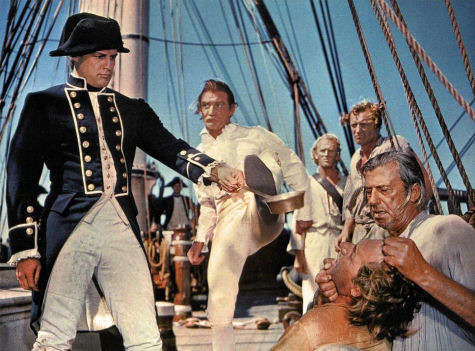
The act that ignites the mutiny scene as Brando’s Fletcher Christian tries to give fresh H20 to a thirsty seaman, and Howard’s Cpt. Bligh expresses his opposition.
Bounty definitely has first-rate dialogue and editing, and three or four scenes that absolutely get the pulse going (leaving Portsmouth, rounding Cape Horn, the mutiny, the burning ship). And I happen to like and respect Brando’s performance — it gets darker and sadder as the film goes along — and you can’t say Trevor Howard‘s Captain Bligh doesn’t crack like a bullwhip. (I read a review that said his emoting was made from “wire and scrap iron”, and that Brando’s came from “tinsel and cold cream”.) And Richard Harris and Hugh Griffith are fairly right-on. And everybody likes the topless Tahitian girls.
You could argue that this Bounty is only nominally about what happened in 1789 aboard a British cargo ship in the South Seas. And you could also say that its prime fascination comes from a portrait of colliding egos and mentalities — a couple of big-dick producers (Aaron Rosenberg was one), several screenwriters, at least two directors (Lewis Milestone, Carol Reed) and one full-of-himself movie star (Brando) — trying to serve the Bounty tale in ’60, ’61 and ’62, and throwing all kinds of money and time and conflicting ideas at it, and half-failing and half-succeeding.
Seen in this context, I think it’s a trip.
I frankly expected WHV to go with a 2.55 to 1 aspect ratio. 2.76 to 1 is fairly radical. It means you’ll be looking at thicker-than-normal black bars above and below the image. (If you want an example, check out the most recent DVD of Ben-Hur.) This means you’d better watch it on a fairly large screen.
Here’s are four samples from Kaper’s score — the overture, an unused overture, a romantic idyll piece on Tahiti and a replay of the main theme.
The Bounty DVD is a two-disc affair, but apparently it won’t offer a “making of” documentary. (The doc on the second disc is called “After the Cameras Stopped Rolling: The Journey of the Bounty”, which obviously isn’t about what happened before and during the rolling of the cameras.) That’s a shame because Bounty‘s production history is one of the most tortured in Hollywood history, marked as it was by constant tempest (Reed was let go, Milestone quit), cost overruns and Brando’s brash big-star behavior. It was almost as costly and disastrous as the shooting of Cleopatra, which opened seven months after Bounty.
(Fox Home Video’s two-disc Cleopatra DVD has a doc that covers the making-of story in fascinating detail, and is actually much more engrossing and entertaining than the film.)
The DVD will also include a prologue and epilogue that was attached to the film for showings on TV in the late ’60s and/or ’70s, but never seen theatrically.
John Huston’s visual scheme for Reflections in a Golden Eye was created with cinematographer Oswald Morris, with whom he created the steely monochrome-ish color for Moby Dick and the rose-tinted, Toulouse Lautrec-ish color for Moulin Rouge.
It used a look of desaturated color with an emphasis on gold and pink. It was supposed to make you feel the perversity and the creepiness that permeates this adaptation of Carson McCullers’ novel, which is about a gay, heavily repressed Army Major (Brando) who ignores his hot-to-trot wife (Elizabeth Taylor) but has a thing for a hunky young private (Robert Forster).
The color succeeded in complementing the vaguely icky mood. Too well, I mean. Viewers complained that it made them feel queasy, and so the color reverted to conventional tones later in the run. The “normal” color also turned up on the VHS version that was sold way back when. WHV’s DVD of the gold-and-pink version will be the first time anyone has seen it in nearly 40 years.
The black-and-white Mutiny stills were sent to me by Roy Frumkes, a friend of restoration guru Robert Harris.
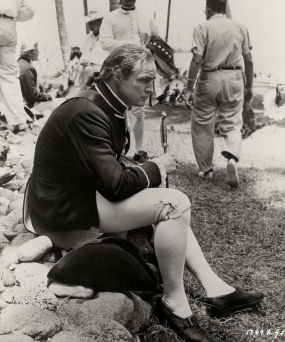
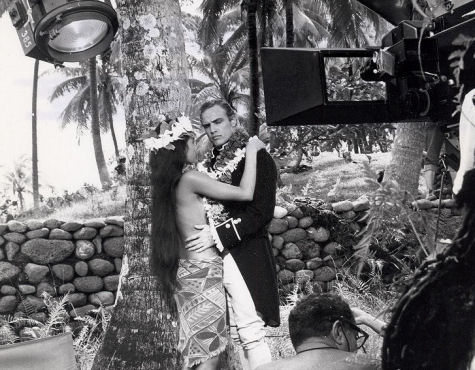
Tarita Teriipia, Brando shooting love scene. Tarita later had two children with Brando, including a troubled daughter, Cheyenne, who committed suicide in 1995.
Smokin’ Aces
I’ve seen a million trailers like this one for Joe Carnahan‘s Smokin’ Aces (Universal, 2.16.07). Why, then, does it seem way hipper than the others? Maybe I’m easily impressed, but it does seem funny. Jeremy Piven (Entourage ‘s “Ari Gold”) is a Vegas stand-up comic who’s decided to rat out some organized crime figures, which of course results in a couple of assassins (Ben Affleck, Alicia Keys) being sent to silence him. And of course there’s an FBI agent (Ryan Reynolds) looking to keep Piven alive. “Forget Hollywoodland — this is the movie that will bring acceptance back to Affleck,” a reader enthused about a half-hour ago.
“Fur” and Nicole
Word around the campfire is that Nicole Kidman‘s performance as celebrated art-gallery photographer Diane Arbus is the best thing about Fur. As for the film itself, some are using the A word, as in “arty.” Or as in, “It turned out a little artier than what some in the loop were expecting.”

In some circles “arty” means index-finger-up-the-butt precious, but shouldn’t an Arbus biopic, of all biopics, have a kind of art-gallery feeling? An aura of artified apartness? If I’d directed this puppy I would have shot it in 35mm black-and-white.
The director is Steven Shainberg (Secrretary), who worked from a script by Erin Cressida Wilson and a book by Patricia Bosworth. Picturehouse is releasing Fur sometime in November, following what I’m told will be a debut at the Toronto Film Festival.
Arbus commited suicide in 1971 at age 48. Why is it that the final acts in the lives of so many gifted 20th Century artists (Arbus, Harry Nilsson, Sylvia Plath, Jean-MIchel Basqiat) end on a black note? Suicide obviously lends a quasi-tragic dimension and also gives the biographer or screenwriter an “ending”, but there are few cliches as groaningly tiresome as that of the self-destructive genius.
Maria Bello’s eyes
I don’t mean to go anal, but there’s this nagging issue with the blue contact lenses that Maria Bello wears for her part as John McLoughlin‘s wife Donna in World Trade Center (Paramount, 8.9). Reader Rich Frank observed yesterday that her eyes “are a weird, translucent blue and the pupils never seem to change size. Every time they went for a close-up I couldn’t help but stare at her eyes. Sure enough, in the photos on her IMDB page her peepers are deep brown.”
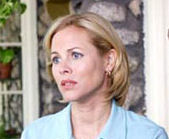

Maria Bello in World Trade Center) (l.) and A History of Violence (r.)
I noticed this too but I tried to push it away. There’s a weirdness in those artifical blues — almost a Village of the Damed quality — and this seems to get in the way of Bello’s fine performance, at least in the early stages. (I forgot about them during the scond half.) I presume Bello used the contacts because Donna’s eyes are blue and she wanted that extra measure of similarity. That’s understandable, but only Donna and her friends and family know she has blue eyes so it obviously didn’t matter that much. It’s not a huge deal but Oliver Stone probably should have said something.
Maybe Bello is one of those actors, like Laurence Olivier, who needs to alter her physicality in some way to get out of her self and become the character. Peter Ustinov once said that in his own skin and using his own voice Olivier never exactly filled the air with electricity. But give him a fake nose or a wig or something that took him out of his natural being and he was off to the races.
“I wouldn’t have mentioned this except it’s the second time in a month that colored lenses have become an issue,” Frank continued. “The same thing happened with Brandon Routh in Superman Returns. I knew going in that he did not have naturally blue eyes, so it became really distracting every time I saw those Master Po contacts.”
WTC strategies, politics
Oliver Stone‘s World Trade Center is being celebrated by the patriot crowd, conservatives and right-leaning pundits as the best hooray-for-the-USA film in a long time. And they’re correct — it does work on this level, although not in any kind of divisive, anti-liberal way. Like I wrote earlier, I’m fine with it. It didn’t offend my political sensibilities, I mean. I can’t imagine it offending anyone’s.
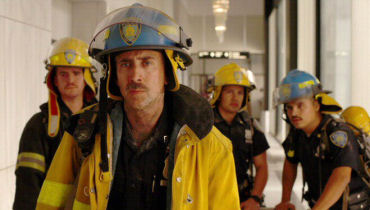
This is why it’s starting to seem likely it’ll be one of the five Best Picture nominees. Because mainstream American moviegoers are always saying Hollywood movies always are a little too caught up in industry lifestyles and liberal attitudes, and here, for a change, is a straight-up emotional film from the heart of the Hollywood beast that any middle-aged Republican farmer from Iowa can go to with his wife and say, “Yeah, my kind of movie.”
This means if it gets Best Picture nominated you know that a lot of the people who profess not to care about the Oscars will probably tune in and root for it. (The last year when the audience jumped as ’99, when Titanic was Best Picture-nominated.) And that means higher ratings and the possibility of higher ad revenues.
It’s good politics to include a “heartland people movie” among the five nominees. That’s why it was a mistake to exclude Walk the Line last year. It deserved to be among the top five anyway, but nominating it for political reasons would have made sense. I realize, obviously, the Academy members don’t weight the political implications of their choices for Best Pictures, but still…
Now that I’m thinking about, I’m wondering why Paramount isn’t sneaking World Trade Center this weekend? Like I wrote yesterday, it’s going to do about $25 million give or take, but it would probably make more than $30 million and the word would go out faster with a nationwide sneak.
“Man” issues
If I could clap my hands three times and rid the world of the Mozilla ActiveX plugin, I would clap my hands three times. You need to load the damn thing to watch trailers on the AOL Moviefone site but which it won’t load. The latest trailer I can’t watch because of this problem is one for Barry Levinson‘s Man of the Year (Universal, 10.13.06), an allegedly shrewd and restrained political comedy with Robin Williams, Laura Linney and Christopher Walken.
A friend who saw Man of the Year at a small screening a few months ago swore up and down it’s funny and corrosive and Levinson’s best since Wag the Dog. But I couldn’t accept her word (she’s not the most cultivated cineaste) so I called Barry’s reps and his producers to ask some questions about it, and they all said “who?…what?…too early.”
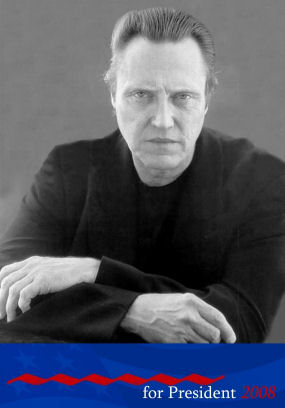
No director has swerved up and down and back and forth like Barry Levinson. Whenever a new movie of his comes along, everyone always asks, “Will it be a good Barry or a bad Barry?” There are actually two bad Barry’s — the guy who makes expensive commercial crap (Sphere, Indiana Holmes and the Temple of Doom) and modest, lower-profile commercial crap (An Everlasting Piece, Envy, Bandits). The good Barry, of course, makes films like
Man of the Year is about a talk show comedian named Tom Dobbs (Williams) who decides to run for president as a goof, but faces some major problems when he unexpectedly wins. Why would that be a problem, I wonder? Would Jon Stewart be in a pickle if he were to run and win? I don’t see why. Chris Rock handled the job okay. The lesson of George Bush is that anyone can be president these days. You don’t need wisdom, character, brains — you just need to win and the determination to try and apply your power. I for one would vote for Walken for president without even thinking about it. I would…really.
Descent
I just thought I’d put up this Descent one-sheet and ask for interpretations. It’s obviously meant to look like a kind of Rorschach ink blot by way of Heironymus Bosch. It seems just as obvious to me that the artist who created this poster had his/her head in Vulvaland. It looks like some kind of mad Dali-esque scene from a Ken Russell movie. The message is either “beware those who would enter this chamber” or that some kind of satori consciousness awaits.


